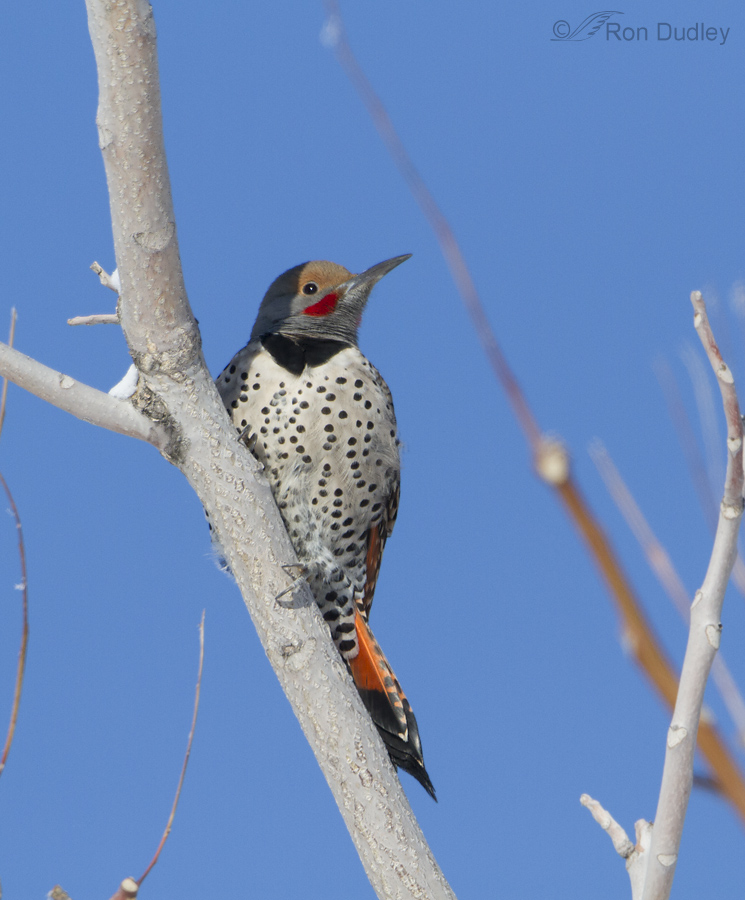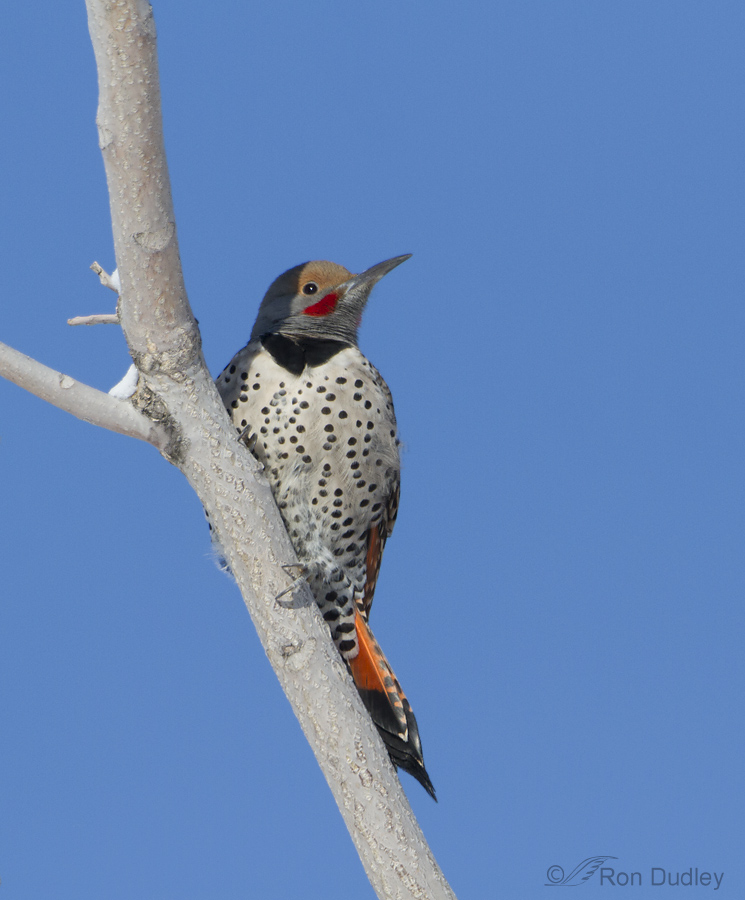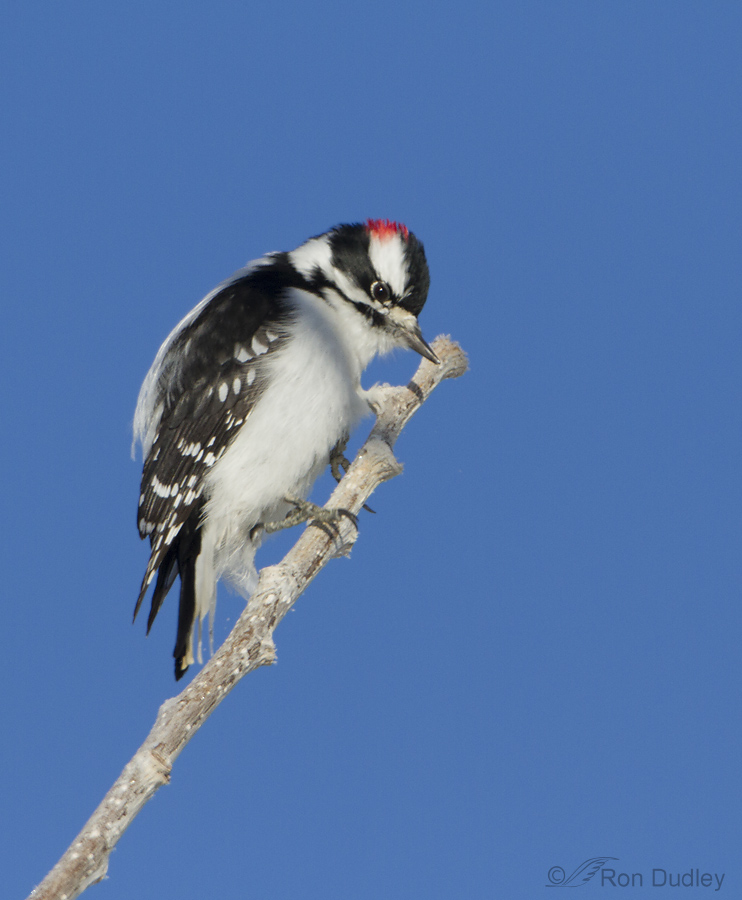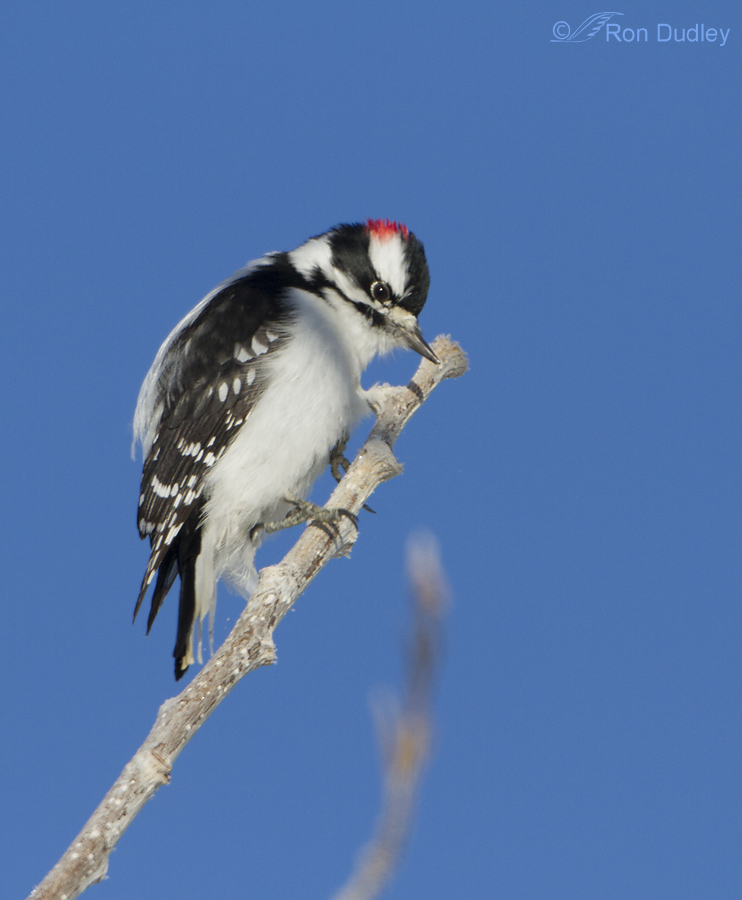I’ve known for years that extremely cold temperatures can make many birds “stickier” – easier to get close to. Two days ago I learned that this maxim also applies to woodpeckers.
1/2500, f/7.1, ISO 500, 500 f/4, 1.4 tc
Monday was one of the coldest days we’ve had in years – it was 12 degrees below zero F when I arrived at Farmington and it only warmed up a few degrees all morning. When I approached this Northern Flicker I fully expected it to vamoose as they nearly always do but it stuck. I suspect there were two reasons for that – the extreme cold and the plethora of twigs and branches it was buried in that gave it a feeling of security.
I like the look at the color under the tail and the red malar of this male but those out of focus branches drive me nuts, so in the end I was seduced by the clone tool.
1/2500, f/7.1, ISO 500, 500 f/4, 1.4 tc, multiple twigs removed
I obviously like this version best but it’s not real – not by a long shot. And after all, I’m a nature photographer. I would never print this version or include it in my galleries but I couldn’t resist seeing what it looked like without all those distractions. The clone tool can really be a temptress…
1/2500, f/7.1, ISO 640, 500 f/4, 1.4 tc, single twig removed
Later in the morning I came across this male Downy Woodpecker that also let me get close. This is the cleanest shot I have of the species but even here I removed a single out of focus twig poking into the frame at bottom.
Is removing a single twig any less offensive than removing many? That’s a question I struggle with because cloning is a slippery slope of degrees – from removing dust spots to adding canvas for composition, to adding catch lights to the eye to cloning elements into the setting that weren’t even there.
Every photographer has some ethical decisions to make on this issue. I try to confine myself to cloning out dust spots and occasionally adding canvas but sometimes I just can’t resist cloning out small, distracting elements.
Like I said, the clone tool is a temptress.
Ron
Addendum: In comments two readers have asked to see the Downy Woodpecker without the out of focus twig removed, so here it is:






I meant to say also that the one of the downy with the blurred branch doesn’t add to the photo at all IMO & I like the shot better without it. Thanks for doing that Ron!
There are 4 reasons I prefer all the branches in the photo. 1.I like that the 3 blurred ones are at the same angle as the large branch he’s on.
2.I like the color of the blurred ones as well as the 2 on the left. It goes with his tail. 3. The large blurred branch kind of frames him in with the one he’s on.
4. The large curved branch on the right is the same curve as his breast & I like that. This picture just makes me happy the way it is. I LOVE IT!!
You have a good eye for detail, Deb. Interesting observations.
These are beautiful shots as they are, I actually prefer the photos with the stray stems. I tend to just see the bird anyway, but if I were painting it, I would leave out the extras to make a cleaner painting. Thus the difference between reality and art, and the preferences we give them.
Excellent point about one of the differences between reality and art, Tana.
Once again, images and comments combine to make my rusty wheels turn..and smoke come out of my ears. After rereading Maya’a comments (and those of others), I realized that regardless of the background, my attention is caught by the subject in its context (environment),then focus is entirely on the subject , then shifts to the subject in the setting, and finally, entirely on the subject (completely oblivious of the background). This also happens when I’m looking through the viewfinder of a camera. My brain is apparently doing its own version of Photoshop….If this “organic photoshopping” happens to you and others, which image is correct”???
“to make my rusty wheels turn..and smoke come out of my ears” – now that brings an image to my mind’s eye, Patty!
And you bring up an interesting point about the potential for “organic photoshopping”. I suspect that process may be different for each of us.
I haven’t read all the responses, but whoa! Blurs aren’t part of the way the natural world presents itself to us, they’re an unfortunate artifact. You might leave all but the blurry branches and still present a beautiful, natural image. I remove blurs. Overall, I prefer to leave as much habitat as is in focus because it makes the photo much more interesting. Blurs, they are the head bangers! Or one could go out at night as William Burt has so extraordinarily done, encased in a cage of lights. I wish I could do that. His photography is sublime and all with the leaves, twigs, grasses, branches and whatnot that surround his subjects.
I love your passion for your point of view, Kelly.
Well, I feel obliged to speak up for the cloned version of the Flicker. It’s stunning in its clean simplicity. Of course it’s not strictly natural, but is it altogether unnatural to choose to direct one’s gaze away from elements that limit intensity of focus on the bird? For instance, something that freely delights my eye is the now-conspicuous echo between the bird’s two elegant forward-facing toes and the two short twig stubs almost identically configured from the left side of the branch. Two simple prongs: one perfection of design, one merest accident, yet they resonate together. My mind’s eye is equally thrilled by the unfettered upward thrust of that powerful beak, nothing blocking the energy of its bold stab into endless blue sky. Yes, the beak of someone who makes a hard living out of the thrust of such a beak! The visual economy of this image even lets the delicate pockets of snow in the angles off the branch stand out as special elements in their own right. No, not the least bit clinical as a setting; just one where distractions no longer draw me away from the simple powerful presence of a bird on its perch in clear blue space. A splendid image that invites attention to details like the startlingly red malar stripe, the graceful shower of spots on a soft gray breast, the surprise of orange under the tail. Stunning photo, Ron. Temptation IS a slippery business. (And not necessarily best described as female –“temptress”– like the archetype attached to poor Eve.). Another point of view for the mix. Thank you.
Temptation IS a slippery business. (And not necessarily best described as female –“temptress”– like the archetype attached to poor Eve.). Another point of view for the mix. Thank you.
Now about the shadow across the bird’s head and nape….
Ron –I don’t know who Maya is, or where she comes from, but she oh so beautifully expresses the feelings of many of us!
I’m glad you like the photo, Maya and I really enjoyed reading the reasons you described for preferring the cloned version. And I agree about the shadow.
However, I think I’ll stick with “temptress”…
An interesting discussion. I fluctuate too. Sometimes it’s the actual position of the out of focus twig, rather than the twig itself that makes me want to clone it. The birds themselves are just beautiful, and I’m really looking forward to seeing any sort of Woodpecker early next year.
I find myself so enchanted by your wonderful images of these amazing flying flowers, and the interesting comments about behaviors, environment, etc. , that a stray twig here or there isn’t even noticed…until you, or someone else, points it out. I can understand your artistic instincts demanding perfection, but you come awfully close time after time.
Thank you very much, Patty.
I’ve been out shooting all morning so I haven’t been able to participate in this discussion until now. I love this kind of give and take – it often makes me reconsider some things, as it has done here. The consensus seems to be to leave the cloned twigs in the image. I’m now somewhere in-between. I’d probably leave in the twigs at lower left and the biggest one at lower right but I really don’t like the 3 that are badly out of focus there. I actually tried a version like that but the fact that the biggest twig on the right was “floating” – not attached to the tree within the image – put me off a little. I’d also crop a little differently so that that twig wasn’t “clipped” at right.
Jerry – thanks for sending me your version of the image. That also contributed to me re-thinking this a bit.
Susan and Patty – it’s partly that our Downy’s aren’t particularly tame and partly that I see so few of them.
Deb and Susan asked to see the Downy image without the twig removed so I’ve added it at the bottom of the post.
As usual, the bird is beautiful Ron. The branches though add habitat, context and poetry, otherwise why not simply drop out the background and have a clinical image of a specimen?
I guess it depends on your personal aesthetic goals and preferences. Audobon, in his iconic illustrations placed the birds in a suggestion of their typical environment. As you know, most field guides suggest typical habitat too!
The first pic is more pleasing, no question about it!
Susan, I also prefer birds “in habitat” but for me the habitat should contribute positively to the image. I just don’t like out of focus twigs in this kind of shot, especially when one’s so close to the face like it is in the flicker image.
I actually prefer the uncloned Flicker – perhaps because it gives me more of a sense of ‘habitat’. And it is your birds rather than their background which keeps me coming back. And back. And back again.
Now these birds I have in my yard. They can be very shy. I don’t have any clear backgrounds. I always have some blured trees or bushes in the background. But it’s the bird I’m interested in. These re great shots. I have no problem with the clone tool!!!
Maybe just taking out the out-of-focus branches would be nice? Either way, the bird remains the subject and the photo is pleasing! I send you a private e-mail with a pic attached.
Very interesting to hear that the Downy Woodpeckers are shy. When I was living in the east and had bird feeders, they would hang around waiting for their favorite one to clear. Sometimes I would swish the curtain on my sliding door to help them out, because that movement made all the birds fly except the Downy Woodpeckers, who immediately moved over to the feeder. I always enjoyed them because they seemed to be ‘thinking’ birds as opposed to ones that reacted without thinking. You have captured both birds nicely. And I, too, would like to see the Downy with the other twig in the picture.
I like the term “thinking birds”… as our chickadees, titmice, Carolina wrens, and downy woodpeckers and a couple of others, seem to fall into that category. Instead of flying off in a “panic”, when we come out to fill the feeders, they hang around and watch, sometimes even hitching a ride as we move the feeder to the storage barrel. Non-scientific, the term no doubt will raise the hackles of super super scientific perennial quibblers (not to be confused with the supercalifragilisticsupercalidocious), but it works for me.
I like the first shot better.For what it’s worth.
Sorry to hear it’s so cold at the moment, Ron. By comparison, we are having one of the mildest winters here in Cornwall – 52F currently. My preference is for your picture containing the foliage, ..mainly because it’s all natural and the colours are appealing. The twigs also lend an interesting three dimensional feel to the whole shot. Stunning images as per usual. Thanks!
Ron, I really like your interest in obtaining a wide range of responses as you consider options. As I use photography and PhotoShop as illustration tools, my frame of reference is quite different, naturally. I respect your hewing to the realistic for gallery showing – it reinforces the integrity of your approach. At the same time, as you are clearly the master of this temptress, I support your experiments! I find PhotoShop so useful to create versions to compare side by side. It helps me refine my sense of composition and to learn how my eye travels with and without backgrounds. I too prefer the first photo. You might try retaining all the branches except the one that extends beyond head height, and then seeing if the remaining soft focus branches bother you…
Alison, I was bothered by the blurry twigs, but the picture changed totally when I looked at it as if the longest one wasn’t there. The other ones don’t distract from the bird the way the long one does. You have a good eye for what works (at least for me…).
Ron-Have you considered the possibility that at 12 below the birds are frozen in place…just as you must have been….Awful!!!
I too like the one with the extra branches Ron. It just seems more real, like I’m actually there in the place looking at it. I would even like to see the Downy shot looks with the twig you removed!
Great shots of two of my favorite birds…love the elegance and colors of the Flicker. Our little Downies are almost as tame as the Chickdees…wish the little devils would stop pecking holes in our house!
What wonderful shots Ron! Thanks for sharing! Stay warm!
Charlotte
We all have our likes and dislikes. I personally don’t mind part of the habitat being in the picture. I have never used a clone tool since I only have Aperture as my workflow software. I have been tempted to buy Lightroom, and just decided to accept a 30 day trial, more because Aperture hasn’t come out with an upgrade to stay in competition with Photoshop/Lightroom. So, the temptress is at bay for now.
Nice shot of both woodpeckers, but I particularly like the one with the sticks showing, but that is just me, although I can see why some would like the Flicker by itself against a blue sky.
Ron. Nothing distracts me when I look at your bird photos. I only see the field marks of the bird that I can identify so clearly in your photos. Thanks